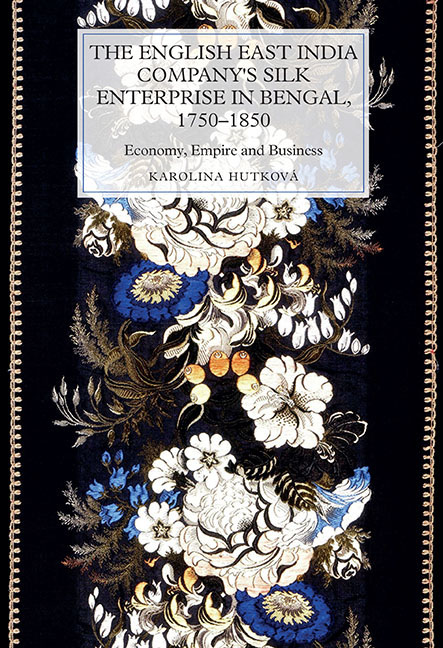Book contents
- Frontmatter
- Contents
- List of Illustrations
- Acknowledgements
- List of Abbreviations
- Measures and Currencies
- Introduction: Companies, Political Economy and the Great Divergenc
- Chapter 1 The Early Modern Silk Industry, Trade and Mercantilism
- Chapter 2 Empire, the English East India Company, and Bengal Raw Silk
- Chapter 3 Bengal, Piedmont and the English East India Company
- Chapter 4 The Bengal Silk Industry and the English East India Company
- Chapter 5 Filatures and Performance in the Bengal Silk Industry
- Chapter 6 The Bengal Silk Industry and British Laissez-Faire Policies
- Chapter 7 Bengal Raw Silk and British Demand in the Nineteenth Century
- Conclusion
- Appendix A Description of the Piedmontese Reeling Machine by Dionysius Lardner
- Appendix B Average Prices of Bengal Raw Silk on the British Market According to the Type of the Silk, 1796–1856
- Appendix C Return on Investment Analysis
- Appendix D Comparison of Manufacturing Costs at the EEIC's Experimental Filature and Common Filature in its Vicinity, 1832
- Appendix E Mechanisation of Silk Throwing and Weaving in England and Scotland, 1856
- Appendix F Types of Silkworm Reared in Bengal Silk Districts, 1818
- Appendix G Glossary
- Bibliography
- Index
- WORLDS OF THE EAST INDIA COMPANY
Chapter 2 - Empire, the English East India Company, and Bengal Raw Silk
Published online by Cambridge University Press: 31 August 2019
- Frontmatter
- Contents
- List of Illustrations
- Acknowledgements
- List of Abbreviations
- Measures and Currencies
- Introduction: Companies, Political Economy and the Great Divergenc
- Chapter 1 The Early Modern Silk Industry, Trade and Mercantilism
- Chapter 2 Empire, the English East India Company, and Bengal Raw Silk
- Chapter 3 Bengal, Piedmont and the English East India Company
- Chapter 4 The Bengal Silk Industry and the English East India Company
- Chapter 5 Filatures and Performance in the Bengal Silk Industry
- Chapter 6 The Bengal Silk Industry and British Laissez-Faire Policies
- Chapter 7 Bengal Raw Silk and British Demand in the Nineteenth Century
- Conclusion
- Appendix A Description of the Piedmontese Reeling Machine by Dionysius Lardner
- Appendix B Average Prices of Bengal Raw Silk on the British Market According to the Type of the Silk, 1796–1856
- Appendix C Return on Investment Analysis
- Appendix D Comparison of Manufacturing Costs at the EEIC's Experimental Filature and Common Filature in its Vicinity, 1832
- Appendix E Mechanisation of Silk Throwing and Weaving in England and Scotland, 1856
- Appendix F Types of Silkworm Reared in Bengal Silk Districts, 1818
- Appendix G Glossary
- Bibliography
- Index
- WORLDS OF THE EAST INDIA COMPANY
Summary
[A]ccording to the most considerable Traders and Manufacturers; it appears that the staple of the Bengal Silk is in quality equal to, and would answer all the purposes of, the Italian or Spanish sorts, if reeled in the same manner, so as to render it easier to wind, and to work with less waste; and that, with such advantages, it would sell at a much higher price than at present […], but if it would wind and Reel as fast as the Piedmont and Italian Sorts, 500 Bales would not be too much for this market, and fetch from 25 to 30 per cent more than it sells for at present, and the lower letters proportionably; even those of D and E might be so perfectly manufactured for answering the uses of the Spanish and Calabria Silk, as to increase 20 per cent on the present price; and no quantity would be too large for sale here.
The history of the British silk industry is inextricably linked with the importation of raw silk. Climatic conditions in Britain do not allow for the rearing of silkworms, thus the rise of silk weaving in the seventeenth century gave an impetus to raw silk imports. Before the late nineteenth century, raw silk came primarily from the Mediterranean, Turkey and Persia. The fact that domestic production prevented the outflow of bullion and gave employment opportunities to the poor, guaranteed silk weaving a privileged position and support from government. The steady demand for raw silk and government backing for the importation of raw silk from the colonies underpinned the English East India Company's interest in Bengal raw silk. Furthermore, the Company needed to expand Indian exports to Britain in order to transfer its Indian Diwani revenues and meet its financial obligations in London.
This combination of factors underlaid the EEIC's perception that Bengal raw silk was one of ‘the choicest goods’, and induced the Company to become a silk manufacturer in Bengal. This chapter argues that the interest in Bengal raw silk was aided by changes to the EEIC's finances in the aftermath of the Battle of Plassey (1757) and the acquisition of the Diwani of Bengal, Bihar, and Orissa (1765).
- Type
- Chapter
- Information
- The English East India Company's Silk Enterprise in Bengal, 1750–1850Economy, Empire and Business, pp. 41 - 66Publisher: Boydell & BrewerPrint publication year: 2019

